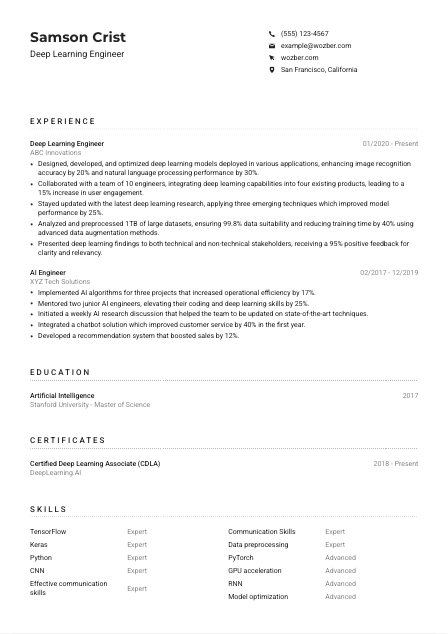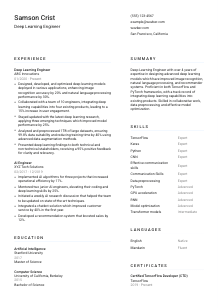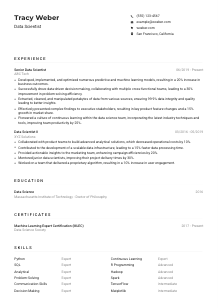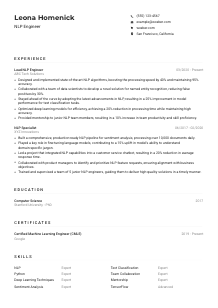Deep Learning Engineer CV Example
Weaving neural nets, but your CV feels shallow? Dive into this Deep Learning Engineer CV example, coded with Wozber free CV builder. Learn how to surface your AI achievements to fit job criteria, setting your career trajectory as deep as your models!

How to write a Deep Learning Engineer CV?
Hello, visionary Deep Learning Engineer! In the realm of artificial intelligence, where innovation meets utility, your CV is more than a piece of paper—it's the code that could launch your dream career. With Wozber's free CV builder at your fingertips, preparing an ATS-compliant CV that aligns perfectly with your desired role's demands is within reach.
This guide, filled with profession-specific tips and encouragement, is your roadmap to a CV that resonates. Let's transform your professional narrative into an invitation for opportunity.
Personal Details
The Personal Details section of your CV is your digital handshake; it's succinct yet impactful, offering a snapshot of your identity in the professional world. Here's how to optimise it for a Deep Learning Engineer position, ensuring alignment with the job requirements.
1. Boldly Brand Your Name
Your name is your banner in the professional arena. Display it prominently, using a clear and professional font. This isn't just typography—it's the first step in branding yourself in the deep learning domain.
2. Align with the Desired Title
Directly beneath your name, articulate the position you're aiming for, in this case, "Deep Learning Engineer." This alignment not only shows your career aspiration but also tailors your CV to the role, making the hiring manager's job easier.
3. Streamline Your Contact Info
"Phone Number: Ensure it's current. Double-check for accuracy. Professional Email Address: Opt for a simple format like firstname.lastname@email.com, reflecting professionalism."
4. Location Matters
The job's locale is critical. By highlighting "San Francisco, California" in your CV, you address one of the employer's explicit needs, demonstrating you're in the vicinity or open to relocating.
5. Web Presence
If you have a LinkedIn profile or personal website showcasing your projects or publications, include it. This is particularly relevant in the tech world, where your digital footprint can significantly bolster your credentials.
Takeaway
Your Personal Details section sets the stage for your professional story. Precision, relevance, and alignment with the Deep Learning Engineer role here are non-negotiable. Treat this section as your professional storefront—it's the first thing employers see. Make it count.





Experience
As a Deep Learning Engineer, your experience is a testament to your capabilities. This section is where you turn theoretical knowledge into demonstrable expertise. Let's mold your experiences to reflect the job description using the Wozber free CV builder for perfect ATS optimisation.
- Designed, developed, and optimised deep learning models deployed in various applications, enhancing image recognition accuracy by 20% and natural language processing performance by 30%.
- Collaborated with a team of 10 engineers, integrating deep learning capabilities into four existing products, leading to a 15% increase in user engagement.
- Stayed updated with the latest deep learning research, applying three emerging techniques which improved model performance by 25%.
- Analyzed and preprocessed 1TB of large datasets, ensuring 99.8% data suitability and reducing training time by 40% using advanced data augmentation methods.
- Presented deep learning findings to both technical and non‑technical stakeholders, receiving a 95% positive feedback for clarity and relevancy.
- Implemented AI algorithms for three projects that increased operational efficiency by 17%.
- Mentored two junior AI engineers, elevating their coding and deep learning skills by 25%.
- Initiated a weekly AI research discussion that helped the team to be updated on state‑of‑the‑art techniques.
- Integrated a chatbot solution which improved customer service by 40% in the first year.
- Developed a recommendation system that boosted sales by 12%.
1. Decode the Job Description
Begin by dissecting the job description. For instance, "Design, develop, and optimise deep learning models" translates to a demand for hands-on experience with model creation and refinement. Highlight experiences that resonate with such requirements.
2. Structuring Your Professional Journey
Chronology matters. Start with your most recent job, ensuring each role is clearly defined. Mention the company, your title, and the dates you were employed, laying the groundwork for a narrative that captures your growth in the field.
3. Highlight Relevant Achievements
For each position, craft bullet points that mirror the ask in the job description, such as "Designed, developed, and optimised deep learning models..." Quantify these achievements where possible—numbers speak volumes.
4. Quantifiable Successes
Did your model enhance image recognition accuracy? By how much? Quantifying your contributions, like a "20% improvement in image recognition accuracy," demonstrates your impact tangibly, making your application more compelling.
5. Relevance is Key
Prioritize experiences directly related to deep learning, AI model development, and collaborative projects. While breadth of experience is beneficial, depth in areas aligned with the job description is what truly sets you apart.
Takeaway
Transform your experience section into a narrative that not only showcases your skill set but also tells a compelling story of growth, challenge, and success in deep learning. Utilize Wozber's ATS optimisation tools, ensuring your CV is not only seen but truly understood.
Education
Your academic credentials lay the groundwork for your expertise. In the field of deep learning, where continual learning and adaptability are key, your education can significantly influence your appeal to potential employers. Here's how to tailor it.
1. Key Requirements First
Highlight your highest degree first, especially if it's a perfect match like a "Master of Science in Artificial Intelligence." Ensure it aligns explicitly with what the job description demands.
2. Structuring with Clarity
Organize this section for easy scanning: Degree, Field, Institution, Graduation Date. Keeping it ATS-compliant means avoiding unnecessary fluff and focusing on the facts.
3. Degree Alignment
If you have a degree in Computer Science or a related field, emphasize it. For instance, showcasing a "Master of Science in Artificial Intelligence" directly parallels the job's educational requirements.
4. Coursework and Projects
While the focus is usually on degrees, don't overlook relevant courses or projects, especially if they're directly applicable to the role of a Deep Learning Engineer. This can illustrate practical experience beyond traditional classroom learning.
5. Additional Credentials
Have you contributed to open-source projects? Published research? These achievements demonstrate a commitment to your field beyond coursework and are particularly valuable in tech roles.
Takeaway
The Education section of your CV is more than a list of schools—it's a curated exhibit of your foundational knowledge and dedication to your craft. Align it with the demands of a Deep Learning Engineer role to show employers you're not just qualified, but prepared to lead in the field.
Certificates
In a continually evolving field like deep learning, certifications play a crucial role in demonstrating continuous learning and specialization. Here's how to highlight them in a manner that speaks directly to hiring managers.
1. Extract From the Job Description
Not all certifications are created equal. Focus on those most relevant to the role, such as "Certified TensorFlow Developer (CTD)," especially when the job description specifies familiarity with specific frameworks.
2. Selection and Priority
Choose certifications that showcase your deep learning competencies and rank them in order of relevance to the position. Prioritize recent certifications to show you're up to date.
3. Dates Matter
Include the date of certification to indicate recency and relevance. For rapidly evolving fields, current knowledge is key, and dates can provide a timeline of your learning journey.
4. Keep Learning
The AI field is constantly advancing. Emphasize your commitment to professional development by pursuing ongoing education and updating your certifications accordingly. This dedication is invaluable in the deep learning arena.
Takeaway
Your certificates are badges of honor, showcasing your specialized knowledge and dedication to staying at the forefront of deep learning advancements. Present them strategically to catch the eye of potential employers.
Skills
The Skills section is where you get to shine a spotlight on your professional capabilities. For a Deep Learning Engineer, this means finely tuning this part of your CV to showcase the technical and interpersonal skills that make you standout.
1. Unpack the Job Description
Scrutinize the job posting for both hard and soft skills. Look for mentions of specific frameworks, programming languages, and collaborative abilities. Matching these with your own skills is crucial for ATS optimisation.
2. Match and Prioritize
Enumerate your skills that align directly with the job specifications. Ensure technical proficiencies like "TensorFlow" or "Keras" are front and center, given their explicit mention in the job description.
3. Organisation is Key
Maintain a structured, easy-to-read layout for your skills section. Use bullet points or a table format to delineate between technical (hard) and interpersonal (soft) skills, ensuring the most relevant are the most noticeable.
Takeaway
A strategically crafted Skills section is not just a list—it's a powerful assertion of your readiness for the role. By precisely matching and arranging your skills, you communicate not just capability, but depth of understanding in the specialized world of deep learning.
Languages
In today's interconnected world, being multilingual can be a significant asset, especially for roles with a potential global impact. The ability to communicate in multiple languages showcases versatility and adaptability—key traits for any Deep Learning Engineer.
1. Job Spec Check
If proficiency in a specific language is a prerequisite, as "Proficient English language communication skills" is stated for this role, ensure to rank this language as your topmost proficiency.
2. Prioritizing Relevance
English tops your language list given its explicit mention in the job description. Subsequently, list other languages you're proficient in, emphasizing those that might have strategic business value.
3. Showcasing Diversity
While the job specifies English, including additional languages showcases cultural adaptability—a plus in diverse teams and global projects. Don't shy away from listing languages like Mandarin if you're fluent.
4. Honesty in Proficiency
Accuracy in self-assessment is key. Be clear about your proficiency levels, using terms like "Native," "Fluent," and "Basic," which offer a straightforward understanding of your language skills.
5. Understanding the Role's Reach
For positions that entail collaboration across geographical boundaries or with international teams, your linguistic skills can be a strong advantage. Highlighting these abilities underscores your potential for broader impact.
Takeaway
Your linguistic capabilities are not mere skills; they are your passport to global opportunities. Showcase them proudly, understanding each language you speak adds a layer of value to your professional profile.
Summary
Your CV summary is where you encapsulate your identity as a Deep Learning Engineer. It's a concise pitch that should resonate with your prospective employer, highlighting why you're not just a great fit, but the perfect one for the role.
1. Essence of the Job
Begin by internalizing the job requirements. For a Deep Learning Engineer, this would mean understanding the demands for technical proficiency, innovation capacity, and teamwork ability.
2. Start with a Bang
Introduce yourself as a professional. Mention your years of experience and key areas of expertise early on to grab attention. For instance, "Deep Learning Engineer with over 4 years of expertise in designing advanced deep learning models..."
3. Address Key Needs
Link your skills and accomplishments directly to what the job description highlights. Demonstrating how you've applied TensorFlow or optimised deep learning models speaks volumes to hiring managers.
4. Keep It Snappy
Your summary should be a potent distillation of your professional self, ideally no more than 3-5 lines. Think of it as your elevator pitch; it needs to be impactful and memorable.
Takeaway
Think of your summary as the gateway to your professional story. It offers a glimpse into your expertise and sets the tone for everything that follows. Tailor it to capture the essence of a Deep Learning Engineer, making it impossible for hiring managers to overlook.
Launching Your Deep Learning Engineer Journey
Congratulations on refining your CV into a tool that not only meets the requirements of a Deep Learning Engineer position but does so with flair and precision. Remember, your CV is a dynamic document. As you grow in your career, revisit and update it to reflect your evolving expertise.
The world is on the brink of AI transformations, and with a CV crafted using Wozber's free CV builder, including the ATS-friendly CV templates and ATS CV scanner for keyword optimisation, you're ready to take center stage. Go forth, inspire innovations, and shape the future.

- Master's or Ph.D. in Computer Science, Electrical Engineering, or a related field.
- Minimum of 3 years of experience in deep learning, specifically with frameworks like TensorFlow, PyTorch, or Keras.
- Strong programming skills in Python and proficiency with GPU acceleration.
- In-depth knowledge of neural network architectures such as CNN, RNN, and Transformer models.
- Effective communication skills and the ability to work collaboratively in a team setting.
- Proficient English language communication skills necessary.
- Must be located in San Francisco, California.
- Design, develop, and optimize deep learning models for various applications in image recognition, natural language processing, or recommender systems.
- Collaborate with cross-functional teams to integrate deep learning capabilities into existing products or develop new solutions.
- Stay updated with the latest research in deep learning and apply emerging techniques to enhance model performance.
- Analyze and preprocess large datasets to ensure its suitability for training deep learning models, including data augmentation and cleaning.
- Present findings, methodologies, and model results to both technical and non-technical stakeholders.















